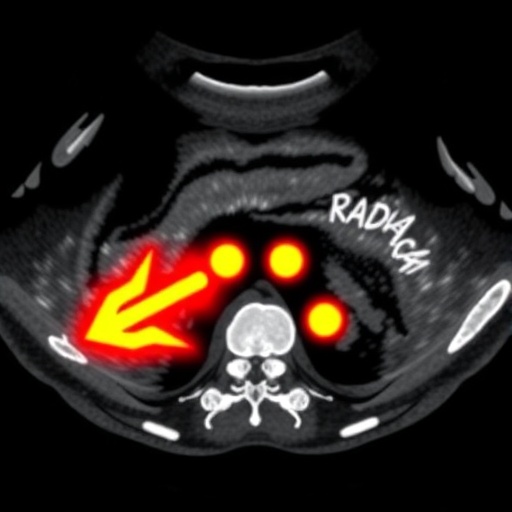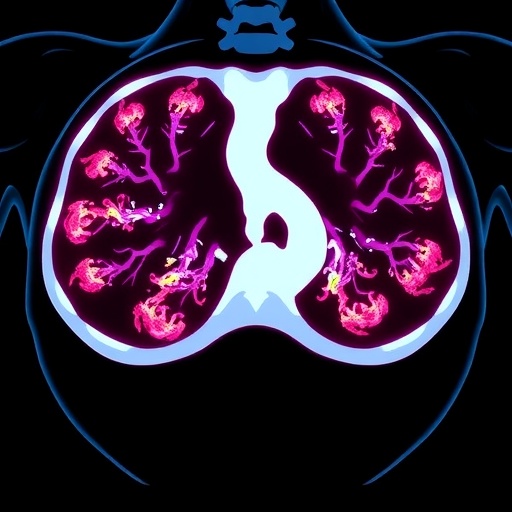In the ever-evolving landscape of breast cancer diagnostics, the integration of artificial intelligence (AI) and advanced imaging techniques has ushered in a new era of precision and efficiency. A recent groundbreaking study published in BMC Cancer in 2025 shines a spotlight on the diagnostic capabilities of ultrasound S-Detect technology, especially in the context of Breast Imaging-Reporting and Data System (BI-RADS) category 4 breast nodules. This research meticulously assesses the performance of S-Detect in evaluating nodules classified as BI-RADS-4, subdivided by size into those measuring 20 millimeters or less and those exceeding 20 millimeters, providing pivotal insights into how AI-assisted ultrasound can redefine clinical workflows.
BI-RADS-4 nodules represent a challenging diagnostic category due to their suspicious nature and varying probabilities of malignancy. Traditional ultrasound evaluations often rely heavily on the radiologist’s subjective interpretation, which can lead to variability in diagnostic accuracy. This study aims to quantify the added value of S-Detect, an AI-based ultrasound analysis tool, in complementing the conventional BI-RADS classification, particularly focusing on lesion size and its impact on diagnostic outcomes.
.adsslot_W9L8umdGko{ width:728px !important; height:90px !important; }
@media (max-width:1199px) { .adsslot_W9L8umdGko{ width:468px !important; height:60px !important; } }
@media (max-width:767px) { .adsslot_W9L8umdGko{ width:320px !important; height:50px !important; } }
ADVERTISEMENT
The findings vividly illustrate that S-Detect, when operationalized alone, demonstrates a remarkable sensitivity particularly in nodules measuring 20 mm or less. Sensitivity for small lesions reached over 92%, surpassing that of the BI-RADS classification system alone, which stood at approximately 77%. This indicates that S-Detect has notable strength in detecting true positives, identifying malignant tumors with high fidelity, thereby enhancing early cancer detection in smaller nodules where diagnosis can often be more ambiguous.
Conversely, specificity—the ability to correctly identify benign nodules—favored conventional BI-RADS scoring over S-Detect in smaller lesions, with specificity values close to 90% compared to S-Detect’s roughly 79%. This suggests that while S-Detect is adept at flagging malignancies, it may yield more false positives, potentially leading to higher biopsy rates if used in isolation.
The combined Co-Detect approach, merging BI-RADS assessment and S-Detect outputs, exhibited superior overall diagnostic performance. For lesions ≤20 mm, the integration propelled accuracy to over 92%, a figure notably higher than either modality alone. The combined method also achieved a specificity above 93%, mitigating the higher false-positive rate seen with S-Detect alone, and maintaining a sensitivity close to 90%, preserving its ability to reliably detect cancerous lesions.
In lesions exceeding 20 mm, all diagnostic approaches performed robustly, with BI-RADS alone yielding a sensitivity and specificity near 89%, while S-Detect’s sensitivity impressively climbed to 98%, albeit accompanied by a dip in specificity to roughly 70%. The combined Co-Detect strategy again outperformed individual methods, achieving an accuracy greater than 95%, effectively balancing the trade-offs between sensitivity and specificity.
The clinical relevance of these findings is underscored by the study’s nuanced analysis of BI-RADS 4A nodules — essentially low suspicion for malignancy. Within this subset, the Co-Detect system effectively downgraded a significant portion of nodules to category 3, which typically warrants less aggressive clinical management. Of these downgraded nodules, a striking 96.4% were confirmed benign upon histological analysis, signaling a meaningful reduction in unnecessary biopsies and the associated patient burden.
However, the study also cautions that a small fraction of downgraded nodules, all measuring 20 mm or less, were false negatives. This highlights an essential caveat: despite high overall performance, clinicians must exercise judicious interpretation and maintain vigilance when utilizing AI-assisted assessments to avoid overlooking malignancies, especially in smaller lesions.
Conversely, the upgrading of certain nodules from BI-RADS 4A to 4B by the Co-Detect method—reflective of an increased suspicion of malignancy—was corroborated by pathological confirmation in 76% of cases. This upgrading mechanism showcases the potential of AI integration to better stratify risk and prioritize cases necessitating urgent intervention.
At the core of this study lies the promise of AI-enhanced ultrasound as a transformative adjunct in breast cancer diagnostics. The S-Detect algorithm employs deep learning models trained to evaluate morphological and textural features extracted from ultrasound images, facilitating objective assessments that can transcend the limitations of human subjectivity. By quantifying lesion attributes—such as shape, margin, echogenicity, and vascular patterns—S-Detect provides a probability score for malignancy that supplements radiologists’ interpretations.
Importantly, the research highlights that the synergistic combination of traditional BI-RADS categorization with AI-generated insights yields diagnostic metrics that surpass either method alone. This fusion leverages the nuanced expertise of radiologists alongside the consistency and data-processing power of algorithms, ultimately providing patients with more reliable, personalized care pathways.
Moreover, the stratification by lesion size unveils critical nuances in diagnostic accuracy, revealing that AI assistance is particularly potent in improving detection for smaller tumors. This size-dependent performance can inform clinical decision-making frameworks, potentially prompting more aggressive monitoring or biopsy recommendations where warranted, while safely reducing interventions in low-risk scenarios.
While these findings herald a new era for ultrasound imaging diagnostics, the authors acknowledge limitations intrinsic to single-institution studies and advocate for broader multicenter trials to validate generalizability. Additionally, the consideration of AI integration within existing clinical workflows demands ongoing collaboration between technologists, radiologists, and oncologists to ensure optimal implementation and training.
Looking forward, the continued evolution of AI in breast imaging portends exciting avenues for enhancing early cancer detection, particularly when coupled with emerging imaging modalities such as elastography or contrast-enhanced ultrasound. Integrative approaches harnessing multimodal data promise to further refine diagnostic accuracy and improve prognostic stratification.
In an age where precision medicine is rapidly reshaping healthcare paradigms, the marriage of human expertise and artificial intelligence in breast cancer diagnostics exemplifies how technology can amplify clinical capabilities. As this study illustrates, ultrasound S-Detect technology, especially when combined with BI-RADS, stands to significantly impact clinical practice by improving diagnostic accuracy, reducing unnecessary invasive procedures, and ultimately enhancing patient outcomes.
As researchers and clinicians continue to unravel the potential of AI-driven diagnostic tools, it becomes imperative to embrace these innovations with both enthusiasm and critical evaluation, ensuring that technological advances translate into meaningful benefits across diverse patient populations.
In sum, this meticulous investigation into the diagnostic performance of ultrasound S-Detect technology offers compelling evidence supporting its integration into the evaluation of BI-RADS 4 breast nodules. Its pronounced sensitivity in smaller lesions, improved specificity when combined with traditional assessments, and ability to stratify risk more accurately highlight a pivotal advancement in breast cancer imaging. Moving forward, such technology may well become indispensable in optimizing breast cancer detection and shaping the future landscape of oncological care.
Subject of Research: Diagnostic performance of ultrasound S-Detect technology in evaluating BI-RADS-4 breast nodules grouped by lesion size (≤ 20 mm and > 20 mm).
Article Title: Diagnostic performance of ultrasound S-Detect technology in evaluating BI-RADS-4 breast nodules ≤ 20 mm and > 20 mm.
Article References:
Xing, B., Gu, C., Fu, C. et al. Diagnostic performance of ultrasound S-Detect technology in evaluating BI-RADS-4 breast nodules ≤ 20 mm and > 20 mm. BMC Cancer 25, 1306 (2025). https://doi.org/10.1186/s12885-025-14760-2
Image Credits: Scienmag.com
DOI: https://doi.org/10.1186/s12885-025-14760-2
Tags: advanced imaging techniques in oncologyAI-assisted ultrasound analysisartificial intelligence in imagingBI-RADS-4 breast nodulesbreast cancer diagnosticsclinical workflow enhancementdiagnostic accuracy in radiologymalignancy probability assessmentnodule size evaluationpatient enrollment in cancer studiestraditional ultrasound limitationsultrasound S-Detect technology





